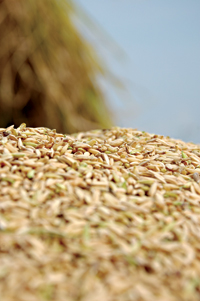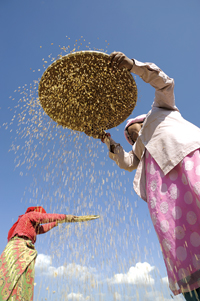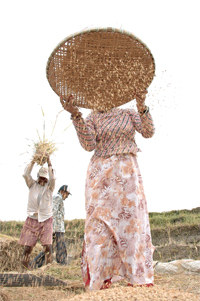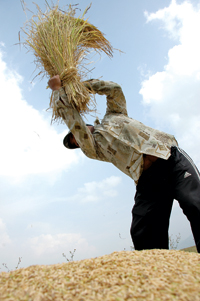September 2011
http://ecs.com.np/feature_detail.php?f_id=497
"People eat what they grow or people grow what they like to eat”, says Wayne Freeman. “I think planners should keep this in mind.” Freeman is an agronomist with specialization in plant breeding who has been credited by some to be the first to introduce the “mansuli” variety of rice in Nepal. He was responding to my query as to why mansuli rice did not find as much favor in countries like Thailand, where it was introduced at the same time, as it did in Nepal. He adds, “Perhaps it’s a question of taste. As far as Nepal is concerned, it is very popular.” What could be the reason? He replies, “Mansuli has exceptional cooking quality and is quite aromatic.”
 So, what was the story behind
mansuli? “Its discovery was more of an accident,” he admits. “Basically
there are two major types of rice, Oryza indica and Oryza japonica. At
one time, some decades ago, it was observed that the far eastern
countries were doing very well with rice cultivation and it was thought
that it must be due to the superiority of the japonica variety. So,
research was conducted in this sector which led to mansuli being
produced as one of its cultivars.” Freeman was then working as a seed
specialist in the Rockefeller Foundation’s Agricultural Program in
India. He apparently introduced the variety in Nepal during his later
posting here. “I was stationed here first in 1976 and retired in 1982.
After that, I worked as a consultant till 1992.”
So, what was the story behind
mansuli? “Its discovery was more of an accident,” he admits. “Basically
there are two major types of rice, Oryza indica and Oryza japonica. At
one time, some decades ago, it was observed that the far eastern
countries were doing very well with rice cultivation and it was thought
that it must be due to the superiority of the japonica variety. So,
research was conducted in this sector which led to mansuli being
produced as one of its cultivars.” Freeman was then working as a seed
specialist in the Rockefeller Foundation’s Agricultural Program in
India. He apparently introduced the variety in Nepal during his later
posting here. “I was stationed here first in 1976 and retired in 1982.
After that, I worked as a consultant till 1992.”
 Age has not stopped him either
from having yet more goals. “I am trying to establish a linkage between
Kansas University and a university in South India,” he reveals. Freeman
is a Rockefeller Foundation joint coordinator who was involved with the
All-India Rice Improvement Program from 1966 to 1976. In fact, that is
not all. Having continued to work as a consultant for many more years,
he declares with some pride, “I have more than 50 years of experience
working in the Indian seed sector.” Freeman is also a Board Member of
the prestigious Barwale Foundation, Hyderabad, which has the following
statement as its vision, ‘To work for alleviation of poverty and improve
livelihoods by increased food security.’ Freeman smilingly discloses
that he is referred to as the ‘visionary member’ of the Board. At this
late stage in his life, his vision is to provide opportunities for
sharing knowledge between his home state and India. One has to wonder at
the man’s spirit. At an age when most people would have called it a day
as far as any sort of activity was concerned, Freeman, at 95, is still
on a mission to have yet another vision fulfilled.
Age has not stopped him either
from having yet more goals. “I am trying to establish a linkage between
Kansas University and a university in South India,” he reveals. Freeman
is a Rockefeller Foundation joint coordinator who was involved with the
All-India Rice Improvement Program from 1966 to 1976. In fact, that is
not all. Having continued to work as a consultant for many more years,
he declares with some pride, “I have more than 50 years of experience
working in the Indian seed sector.” Freeman is also a Board Member of
the prestigious Barwale Foundation, Hyderabad, which has the following
statement as its vision, ‘To work for alleviation of poverty and improve
livelihoods by increased food security.’ Freeman smilingly discloses
that he is referred to as the ‘visionary member’ of the Board. At this
late stage in his life, his vision is to provide opportunities for
sharing knowledge between his home state and India. One has to wonder at
the man’s spirit. At an age when most people would have called it a day
as far as any sort of activity was concerned, Freeman, at 95, is still
on a mission to have yet another vision fulfilled.
 Freeman originally hails from Gatlinburg in Kansas which he
says, “is right next to Smoky Mountain National Park, the most visited
park in the United States.” Now he lives in Tennessee. He was one of the
first to receive a scholarship from the National Youth Administration
set up during President Roosevelt’s time, the purpose of which was to
provide support to students wanting to go to college. Initially, Freeman
wanted to be a veterinarian, but a summer job involving agronomy led to
him changing his mind. In due time, after finishing his graduation in
the subject from Kansas, he did his masters from Illinois, specializing
in plant breeding.
Freeman originally hails from Gatlinburg in Kansas which he
says, “is right next to Smoky Mountain National Park, the most visited
park in the United States.” Now he lives in Tennessee. He was one of the
first to receive a scholarship from the National Youth Administration
set up during President Roosevelt’s time, the purpose of which was to
provide support to students wanting to go to college. Initially, Freeman
wanted to be a veterinarian, but a summer job involving agronomy led to
him changing his mind. In due time, after finishing his graduation in
the subject from Kansas, he did his masters from Illinois, specializing
in plant breeding.
 He is not satisfied with something
else too. Right at the beginning of our talk, he had said that when he
comes here, one of the things he was interested in knowing was whether
the fruits of all the efforts put in over the decades have been
realized. So, I ask him, “Do you think Nepal has been successful?” He
looks sad when he says, “In relation to India, no.” Clearly, he is
tempering his words.
He is not satisfied with something
else too. Right at the beginning of our talk, he had said that when he
comes here, one of the things he was interested in knowing was whether
the fruits of all the efforts put in over the decades have been
realized. So, I ask him, “Do you think Nepal has been successful?” He
looks sad when he says, “In relation to India, no.” Clearly, he is
tempering his words.
http://ecs.com.np/feature_detail.php?f_id=497
"People eat what they grow or people grow what they like to eat”, says Wayne Freeman. “I think planners should keep this in mind.” Freeman is an agronomist with specialization in plant breeding who has been credited by some to be the first to introduce the “mansuli” variety of rice in Nepal. He was responding to my query as to why mansuli rice did not find as much favor in countries like Thailand, where it was introduced at the same time, as it did in Nepal. He adds, “Perhaps it’s a question of taste. As far as Nepal is concerned, it is very popular.” What could be the reason? He replies, “Mansuli has exceptional cooking quality and is quite aromatic.”
 So, what was the story behind
mansuli? “Its discovery was more of an accident,” he admits. “Basically
there are two major types of rice, Oryza indica and Oryza japonica. At
one time, some decades ago, it was observed that the far eastern
countries were doing very well with rice cultivation and it was thought
that it must be due to the superiority of the japonica variety. So,
research was conducted in this sector which led to mansuli being
produced as one of its cultivars.” Freeman was then working as a seed
specialist in the Rockefeller Foundation’s Agricultural Program in
India. He apparently introduced the variety in Nepal during his later
posting here. “I was stationed here first in 1976 and retired in 1982.
After that, I worked as a consultant till 1992.”
So, what was the story behind
mansuli? “Its discovery was more of an accident,” he admits. “Basically
there are two major types of rice, Oryza indica and Oryza japonica. At
one time, some decades ago, it was observed that the far eastern
countries were doing very well with rice cultivation and it was thought
that it must be due to the superiority of the japonica variety. So,
research was conducted in this sector which led to mansuli being
produced as one of its cultivars.” Freeman was then working as a seed
specialist in the Rockefeller Foundation’s Agricultural Program in
India. He apparently introduced the variety in Nepal during his later
posting here. “I was stationed here first in 1976 and retired in 1982.
After that, I worked as a consultant till 1992.”
“The late Gyan Lal Shrestha of Parwanipur Rice
Station (near Birganj in the Terai) was also involved in this.” It seems
that Freeman and Shrestha began the first cultivation of mansuli rice
in Nepal. The fact that the origins are a bit hazy is because Wayne
Freeman is not in his prime today and cannot be faulted for not
remembering more clearly. He is 95 years old as we speak. Yes, you heard
right, ninety-five. Memories do become a bit clouded, which is not to
say that he does not remember much. On the contrary, he is surprisingly
sharp for his age and more amazing still, age hasn’t stopped him from
traveling the world. We had this conversation at Hotel Himalaya,
Lalitpur, in the second week of March this year. He was on a week-long
visit. He would be leaving for Hyderabad a few days later to attend a
workshop on rice on the 8th of April. After that, he would be flying
back to Kansas in the United States to speak at a Leadership Council
Meeting.
 Age has not stopped him either
from having yet more goals. “I am trying to establish a linkage between
Kansas University and a university in South India,” he reveals. Freeman
is a Rockefeller Foundation joint coordinator who was involved with the
All-India Rice Improvement Program from 1966 to 1976. In fact, that is
not all. Having continued to work as a consultant for many more years,
he declares with some pride, “I have more than 50 years of experience
working in the Indian seed sector.” Freeman is also a Board Member of
the prestigious Barwale Foundation, Hyderabad, which has the following
statement as its vision, ‘To work for alleviation of poverty and improve
livelihoods by increased food security.’ Freeman smilingly discloses
that he is referred to as the ‘visionary member’ of the Board. At this
late stage in his life, his vision is to provide opportunities for
sharing knowledge between his home state and India. One has to wonder at
the man’s spirit. At an age when most people would have called it a day
as far as any sort of activity was concerned, Freeman, at 95, is still
on a mission to have yet another vision fulfilled.
Age has not stopped him either
from having yet more goals. “I am trying to establish a linkage between
Kansas University and a university in South India,” he reveals. Freeman
is a Rockefeller Foundation joint coordinator who was involved with the
All-India Rice Improvement Program from 1966 to 1976. In fact, that is
not all. Having continued to work as a consultant for many more years,
he declares with some pride, “I have more than 50 years of experience
working in the Indian seed sector.” Freeman is also a Board Member of
the prestigious Barwale Foundation, Hyderabad, which has the following
statement as its vision, ‘To work for alleviation of poverty and improve
livelihoods by increased food security.’ Freeman smilingly discloses
that he is referred to as the ‘visionary member’ of the Board. At this
late stage in his life, his vision is to provide opportunities for
sharing knowledge between his home state and India. One has to wonder at
the man’s spirit. At an age when most people would have called it a day
as far as any sort of activity was concerned, Freeman, at 95, is still
on a mission to have yet another vision fulfilled.
But, hold on, that’s not his only remaining
vision. He lets me know that he is waiting eagerly for his book to be
released by the end of this year. It is titled, “The History of the
Indian Seed Industry.” And, here would be the right time to reemphasize
that his mind remains quite sharp today. Talking about his family, he
says, “I was married in January 1938.” He has a son and two daughters
and plenty of grand children as well as great grand children. Regarding
his obviously healthy longevity, he says, “My grandfather was born in
1812 and died in 1911. He lived for 99 years! On my mother’s side, her
parents too lived to be in their nineties. So, perhaps it’s the genes.”
He adds, “Recently my doctor told me that I had exceptionally good
intestinal health. Maybe it’s due to the diet, you know, fresh greens
and less meat.”
 Freeman originally hails from Gatlinburg in Kansas which he
says, “is right next to Smoky Mountain National Park, the most visited
park in the United States.” Now he lives in Tennessee. He was one of the
first to receive a scholarship from the National Youth Administration
set up during President Roosevelt’s time, the purpose of which was to
provide support to students wanting to go to college. Initially, Freeman
wanted to be a veterinarian, but a summer job involving agronomy led to
him changing his mind. In due time, after finishing his graduation in
the subject from Kansas, he did his masters from Illinois, specializing
in plant breeding.
Freeman originally hails from Gatlinburg in Kansas which he
says, “is right next to Smoky Mountain National Park, the most visited
park in the United States.” Now he lives in Tennessee. He was one of the
first to receive a scholarship from the National Youth Administration
set up during President Roosevelt’s time, the purpose of which was to
provide support to students wanting to go to college. Initially, Freeman
wanted to be a veterinarian, but a summer job involving agronomy led to
him changing his mind. In due time, after finishing his graduation in
the subject from Kansas, he did his masters from Illinois, specializing
in plant breeding.
When the talk veers towards Kansas, Freeman
recalls something that he is a bit excited about. “A certain Dr. Chu at
the Kansas State University is doing work involving double haploid
breeding. Right now the tests are being done on wheat but could as well
be applicable to other cereals later on. If it is successful, it will be
possible to grow cereals much faster than with the conventional cross
bred varieties.” He also mentions a bansmati hybrid called RH10
developed by the Indian Agricultural Research Institute and which was
introduced in India in 2005. Actually, this is where Freeman wants to
comes into the picture. He wants to develop linkages between the United
States and India so that such research can move ahead faster due to
collaboration and joint efforts. No wonder the Barwale Foundation
acknowledged that, “One of his (Wayne Freeman’s) most prominent
contributions was to accelerate research and development on an
interdisciplinary multi-location basis, which has become a model for
IRRI’S International rice testing program also.” But, it seems that the
95-year-old is not yet satisfied with the status quo and is working
towards speeding things up further.
 He is not satisfied with something
else too. Right at the beginning of our talk, he had said that when he
comes here, one of the things he was interested in knowing was whether
the fruits of all the efforts put in over the decades have been
realized. So, I ask him, “Do you think Nepal has been successful?” He
looks sad when he says, “In relation to India, no.” Clearly, he is
tempering his words.
He is not satisfied with something
else too. Right at the beginning of our talk, he had said that when he
comes here, one of the things he was interested in knowing was whether
the fruits of all the efforts put in over the decades have been
realized. So, I ask him, “Do you think Nepal has been successful?” He
looks sad when he says, “In relation to India, no.” Clearly, he is
tempering his words.
No comments:
Post a Comment